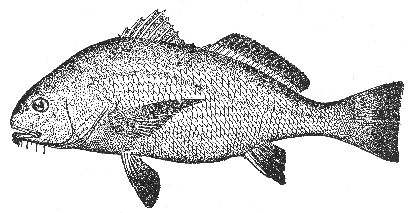Black drum[98] Pogonias cromis (Linnaeus) 1766
[Jordan and Evermann, 1896-1900, p. 1482.]

Figure 220.—Black drum (Pogonias cromis). From Goode. Drawing by H. L. Todd.
Description—
A short deep body (less than three times as long as it is deep to the base of the caudal fin) with high-arched back but flattish belly is characteristic of the drum. The profile of the face is even more diagnostic, for the mouth is horizontal and set very low, the eye high, and the chin bears several barbels. The arrangement and sizes of the fins are essentially the same as in the weakfish, except that the second (soft-rayed) dorsal is relatively shorter, and that the anal spine is much stouter. The jaw teeth are small and [page 426] pointed, but the throat is armed with large, flat, pavement-like teeth with which the drum crushes shellfish for food, a character separating it from its allies the weakfish and the kingfish. The first dorsal fin (10 spines) is rounded-triangular; the second (1 short spine and 20 to 22 rays) oblong; the caudal is square-tipped with moderately high peduncle; the anal fin (2 spines, the first very short and the second long and stout, and 6 or 7 soft rays) is less than half as long as the soft dorsal; the pectorals are sharp pointed and relatively longer than those of the weakfish. The second anal spine is much stouter in young drums than in old ones. The eyes of the drum are comparatively small and its scales are large.
Color—
Silvery with a brassy lustre, turning to a dark gray after death. Young fish have 4 or 5 broad dark vertical bars that fade out with age. The fins are blackish. This drum occurs in two color phases, a grayish and a reddish.
Size—
Drums grow to a huge size. The largest we find positively recorded (caught in Florida) weighed 146 pounds; adults, as caught, run from 20 to 40 pounds, with 60 pounds not exceptional. The rod and reel record is 87 pounds 8 ounces, a fish 4 feet 4 inches long, caught at Cape Charles, Va., May 6, 1950, by Mrs. H. A. Bradley, Jr. A fish 40 inches long weighs about 40 pounds.
General range—
Atlantic and Gulf of Mexico coasts of America from Argentina to southern New England; common from New York southward and abundant from the Carolinas to the Rio Grande; a stray visitor as far north as Massachusetts Bay.
Occurrence in the Gulf of Maine—
This southern fish is decidedly uncommon east of New York; occasional specimens only have been reported from Woods Hole; and it is only a stray visitor to our Gulf, where 2 or 3 specimens have been taken at Provincetown, and 1 in the Mystic River, which empties into Boston Harbor.
[98] The channel bass or red drum Sciaenops ocellatus (Linnaeus) 1766, a southern sciaenid uncommon east or north of New York, is represented in the collection of the Boston Society of Natural History by a mounted specimen labeled "near Portland, Me.," but as this fish was probably purchased in the market, it is likely that it had been shipped from the south than that it was actually caught nearby. Should this drum ever be taken in the Gulf of Maine, its relationship to the weakfish, kingfish, and spot would be apparent from the arrangement of its fins, especially from the shortness of the anal fin relative to the soft (second) dorsal. But it is easily distinguished from the weakfish by the fact that its upper jaw extends beyond the lower instead of vice versa; from the spot, by the barbels on its chin; and from the kingfish by having several of these barbels instead of only one; by the shape of its tall fin; and by the presence of a conspicuous black blotch (sometimes as many as 4 or more blotches) on each side at the base of the caudal fin which affords a ready field mark for its identification.